Key Points:
- The Columbia River runs from Canada and ends in Astoria, Oregon, and dumps into the Pacific Ocean. The river’s mouth is one of the most dangerous river bar crossings in the world.
- The river is 1,243 miles long and contains thousands of species of wildlife.
- A few of the animals that live at the bottom of this river are chinook salmon, American bullfrog, and Pacific lamprey.
Since its discovery by European settlers in 1775, the Columbia River has played an important role in the development of the Pacific Northwest. Today, numerous locks and dams exist along the lower legs of the river. In fact, the dams on the river’s main stem and tributaries produce nearly 44% of all hydroelectric power in the United States. The river acts as an important shipping channel for goods from Canada and the interior U.S. to reach the Pacific Ocean. Additionally, its watershed drains into an area the size of France and plays an important role in agricultural production in the region.
The Columbia River also supports a healthy ecosystem of diverse plants and animals. Numerous animals live along its banks, including mammals like deer, black bears, and bobcats. Hundreds of bird species visit the river during annual migrations or live on the river year-round, including herons, cormorants, and owls. Several anadromous fish live in and travel along the river, including six species of salmon. Given this incredible diversity, it begs the question: what lives at the bottom of the Columbia River?
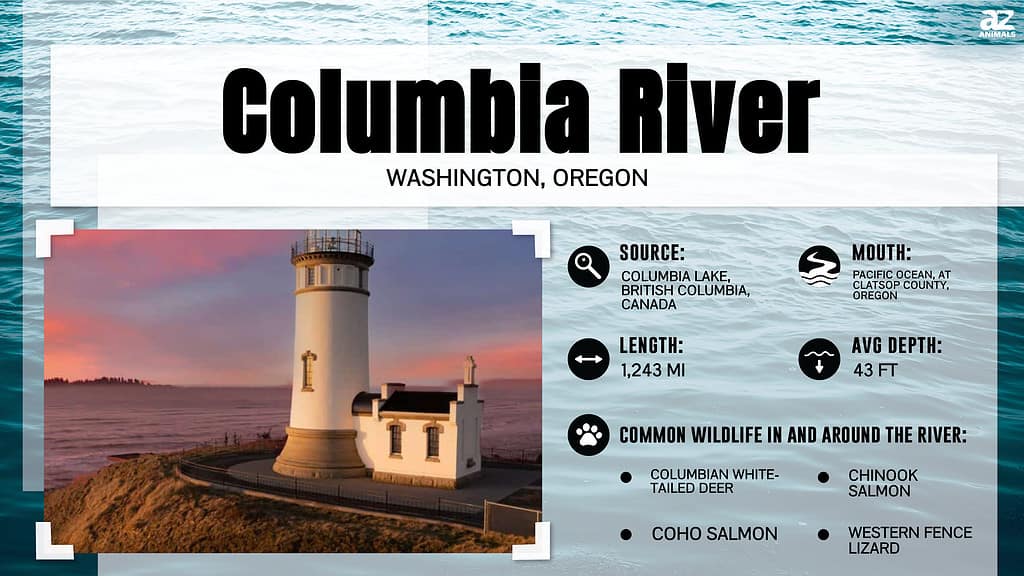
Keep reading to learn all about the incredible creatures that call the Columbia River home. You’ll also learn about the river itself, where it’s located, and the dangers it poses.
About the Columbia River
The Columbia River begins in southern British Columbia at Columbia Lake. From there, it flows northwest through the Canadian Rockies and Columbia Mountains, past Windermere Lake and Kinbasket Lake. After passing the Selkirk Mountains, the river turns abruptly south and flows south into Washington. Upon reaching the Washington-Oregon border, the river then cuts west and forms the border between the two states. Its journey ends at the confluence of the river and the Pacific Ocean.
In total, the Columbia River measures 1,243 miles, which makes it the largest river in the Pacific Northwest. Moreover, it ranks as the 4th largest river in the United States in terms of volume. Its drainage basin covers seven U.S. states, including Washington, Oregon, Montana, Idaho, Nevada, Utah, and Wyoming. Several tributaries feed into the Columbia River on its journey from Canada to the Pacific Ocean. Its major tributaries include the Snake River, Willamette River, Kootenay River, and Pend Oreille River.
The Columbia River has a long and storied history. Indigenous peoples lived along its banks for more than 15,000 years. Some of the Native American and First Nations tribes that called the river home include the Spokane, Coeur d’Alene, Nez Perce, Yakama, and Palus. The arrival of European settlers in the 18th century kickstarted a rapid change in the appearance and structure of the river. Over the years, the river has been dredged and dammed numerous times to improve navigation along its course for commercial ships, control flooding, and generate hydroelectric power for the region.
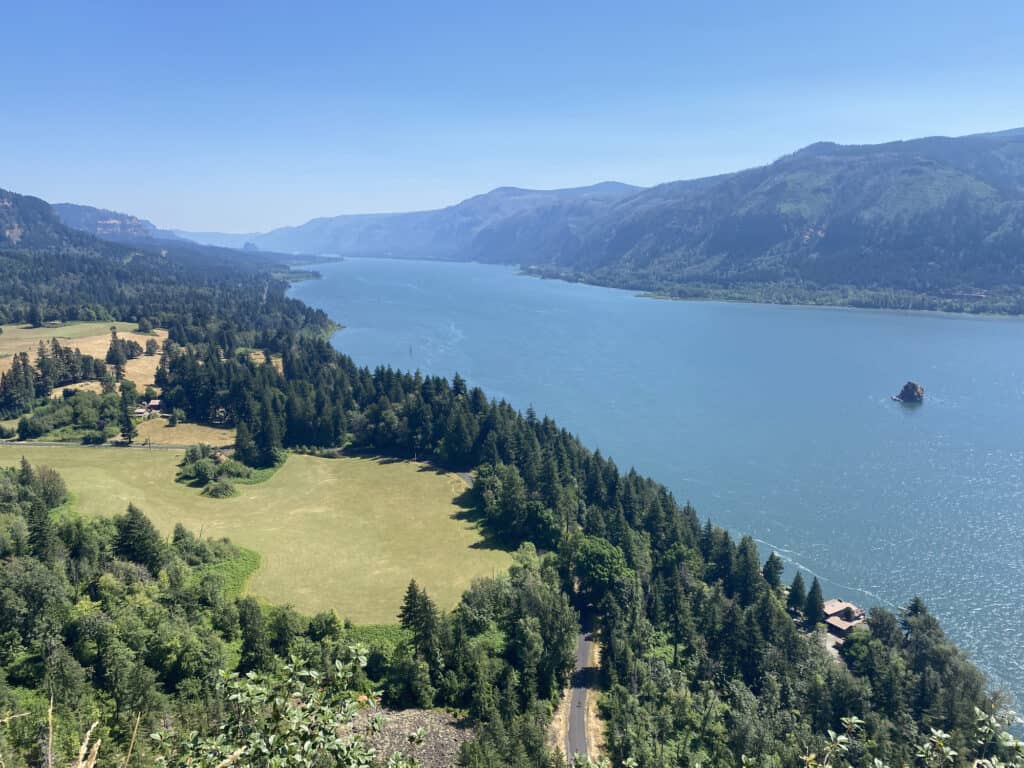
The Columbia River measures 1,243 miles, which makes it the largest river in the Pacific.
©iStock.com/Sharla Libera
Where to Find the Columbia River on a Map
The Columbia River is a major waterway in North America that flows through the Pacific Northwest region of the United States and Canada. The river begins in the Rocky Mountains of British Columbia, Canada, and runs over 1,200 miles before emptying into the Pacific Ocean at Astoria, Oregon. To find it on a map, look for the states of Washington and Oregon or search for cities such as Portland or Vancouver along its banks. The river’s watershed covers nearly 260,000 square miles and includes numerous tributaries like the Snake River and Yakima River.
Is the Columbia River Dangerous?
Located at the mouth of the Columbia River, the Columbia Bar is one of the most dangerous bar crossings in the world. When the Columbia River empties into the ocean, it creates large standing waves. Unlike many other large rivers, the Columbia River lacks a river delta. A delta helps to dissipate a river’s discharge over a wide area. The Columbia River’s lack of a delta, along with strong winds and ocean swells, combine to create deadly water conditions. Over the last 200 years, more than 2,000 ships have sunk near the mouth of the Columbia River. As a result, people often refer to the Columbia Bar as the Graveyard of the Pacific.
In addition to being one of the most dangerous commercial shipping bars in the world, the Columbia River also features one of the most polluted stretches of river worldwide. A 50-mile stretch of the river in southeastern Washington passes by the Hanford Site. Establish in 1943, the Hanford Site produced plutonium for the Manhattan Project. The pumps at the site drew water from the Columbia River to cool its 9 nuclear reactors. Later, these same pumps then dumped that radiated water back into the river. This went on from 1944 to 1971, and the process severely impacted the Columbia River. Today, radioactive runoff from the now-decommissioned plant’s underground storage tanks is slowly making its way toward the river. If this is not addressed, experts expect the waste will reach the river and cause catastrophic environmental damage.
What Lives at the Bottom of the Columbia River?
The Columbia River Basin supports hundreds of different animals and thousands of unique plant species. Every year, the river witnesses giant migrations of anadromous fish that travel from the Pacific Ocean upriver to their spawning grounds. Many animals rely on these migrations to survive, from eagles and black bears to small invertebrates and insects. Let’s take a look at a few of the species you can find at the bottom of the Columbia River.
Chinook Salmon
Also known as the king salmon, the Chinook salmon is the largest Pacific salmon in the Columbia River. It gets its name from the Chinook people, a group of Chinookan-speaking tribes who lived along the Columbia River for thousands of years. Chinook salmon are anadromous, meaning they spend their lives in both saltwater and freshwater. They live most of their lives in the ocean, then return to freshwater to spawn. Chinook salmon appear blue-green, purple, or red along the back and have silvery sides. You can distinguish them from other salmon by the black spots on their upper sides and tails. They range from 24 to 58 inches long and can weigh up to 130 pounds. Anglers prize them for their large size and great taste. Unfortunately, damming along the Columbia River has significantly impacted the Chinook salmon runs. This has led to population declines in the past few decades.
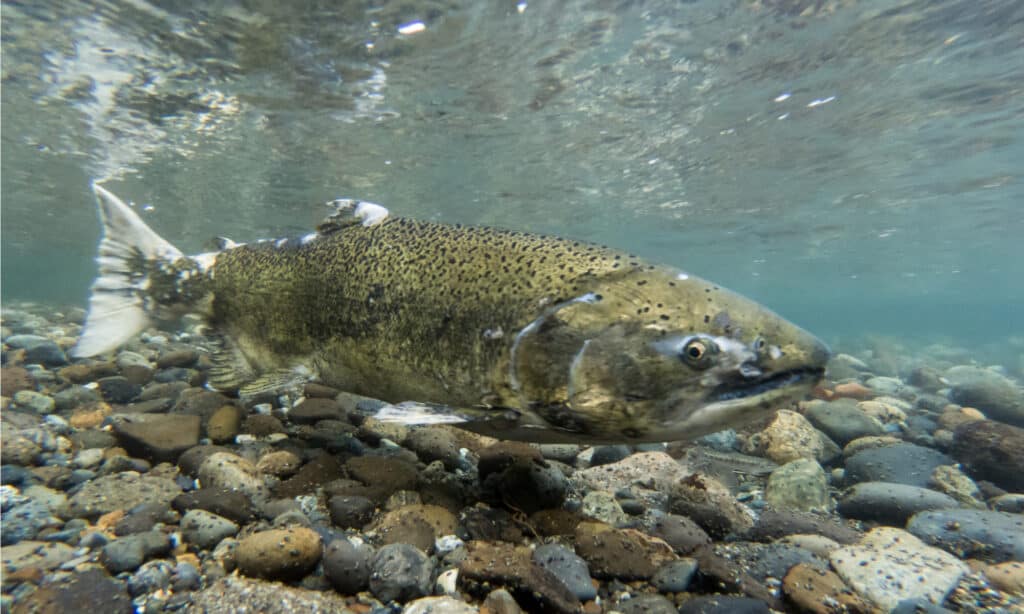
Chinook salmon has a long, tapered body with a blue-green back, a silver sheen on its sides, and a white belly.
©Kevin Cass/Shutterstock.com
American Bullfrog
While not native to the Columbia River, the American bullfrog has become a common sight along the river. This invasive species hails from the eastern half of North America, where it commonly lives in ponds, streams, rivers, and lakes. American bullfrogs usually have olive-colored backs and whitish bellies. They possess short, powerful front legs and long hind legs. Adults range in size from 3.6 to 6 inches long, with males usually measuring larger than females. They can weigh up to 1.8 pounds, although most specimens weigh a little less than a pound. American bullfrogs are quite aggressive and have voracious appetites. During the breeding season, males produce loud sounds similar to the bellowing of a bull, hence their name. American bullfrogs are commonly eaten in the American south and are frequently used in laboratories for scientific experiments.
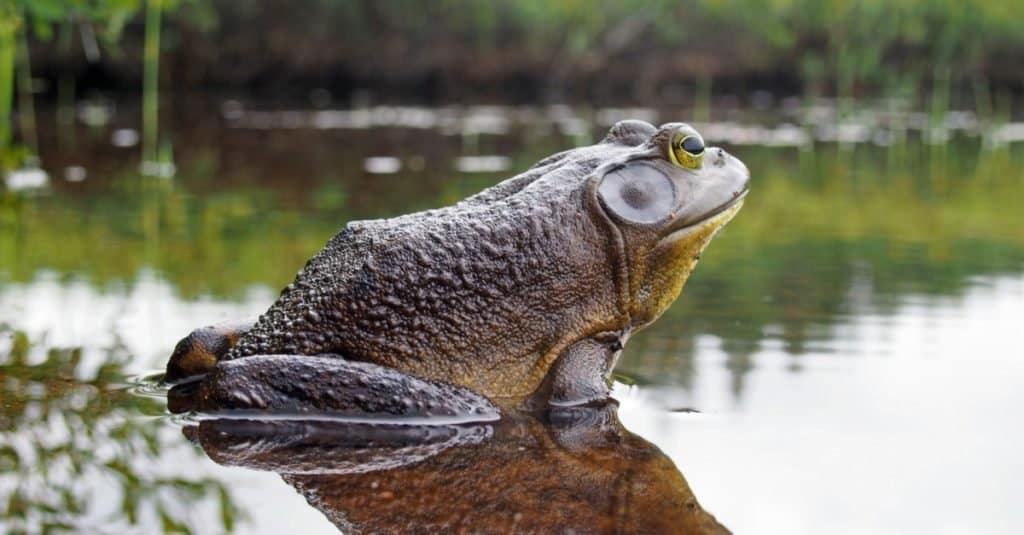
North American bullfrogs have a bellowing call that sounds a bit like a foghorn.
©Christian Ouellet/Shutterstock.com
Pacific Lamprey
The Pacific lamprey is one of the most unusual-looking creatures found at the bottom of the Columbia River. This anadromous parasite also goes by the name the three-tooth lamprey and tridentate lamprey. Adult pacific lampreys can grow up to 31 inches long. They possess long, narrow bodies that change color depending on their environment. At sea, they appear either green or bluish-black, while in freshwater, they appear brown. That said, their mouth is their most distinguishing feature, thanks to the three sharp teeth that grow above and on each side of the mouth. Like salmon, Pacific lampreys spawn in freshwater and then journey out to seed to feed and grow. A single female can lay up to 100,000 eggs, which the males fertilize externally. Historically, numerous Native American tribes harvested Pacific lampreys for use in traditional ceremonies and to feed to children due to their high-fat content.

At sea, lampreys appear either green or bluish-black, while in freshwater they appear brown.
©Andrei Nekrassov/Shutterstock.com
Western Pearlshell
The western pearlshell is a freshwater pearl mussel in the family Margaritiferidae. It lives only in the United States and Canada and was historically found extensively throughout the Columbia River. Western pearlshells live in close proximity to salmon and other salmonid fish, as these fish serve as hosts for the mussel larvae. The larvae hook onto the gills, fins, and scales of fish using specialized hooks. Once they grow large enough, they detach and float down to the substrate where they mature into juvenile mussels. According to some estimates, western pearlshells can live 100 years or more. They serve an important role in the environment by filtering water and providing food for numerous animals. Until relatively recently, you could find them throughout the cold freshwater streams of the Pacific Northwest. Due to declining populations brought on by habitat loss, the IUCN lists the western pearlshell as a Near Threatened species.
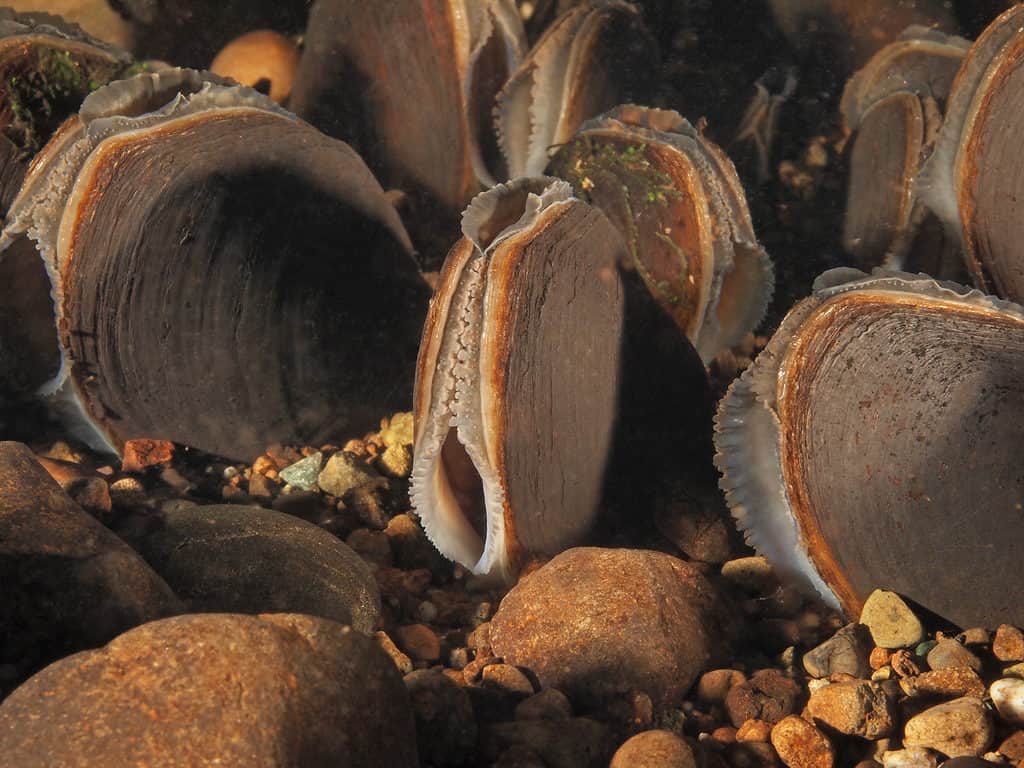
Western pearlshells live only in the United States and Canada.
©USFWS – Pacific Region/Flickr – License
Steelhead Salmon
The steelhead salmon is an anadromous version of the rainbow trout. Adult cans grow up to 20 pounds, although they typically weigh between 1 and 5 pounds. They vary in color but usually appear silvery with a faint red stripe down each side. Steelhead salmon spawn in freshwater and then travel to saltwater to feed and grow. They are one of the most invasive species in the world and have spread to numerous non-native habitats. Steelhead salmon feed on a wide variety of prey animals, including insects, crustaceans, and other fish. Anglers prize steelhead salmon both for their taste, color, and willingness to fight once they grab hold of a fishing line. In addition to wild populations, numerous hatcheries exist that raise steelhead salmon on farms. Unfortunately, wild populations are on the decline due to habitat loss.
Interesting Facts
- The Columbia River is the largest river that flows into the Pacific Ocean in North America.
- The deepest part of the Columbia River measures nearly 300 feet deep.
- People have lived along the Columbia River for nearly 15,000 years.
- The Lower Columbia River and its tributaries feature nearly 30 dams.
- In a good year, nearly 1 million salmon return to the Columbia River to spawn.
The photo featured at the top of this post is © iStock.com/JPLDesigns
Thank you for reading! Have some feedback for us? Contact the AZ Animals editorial team.






